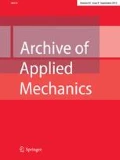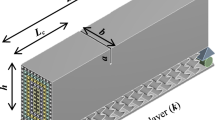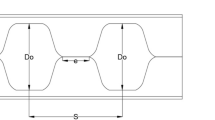Abstract
Fastener holes used in the mechanical joints are vulnerable to failure due to development of stress concentration at their edges. Inducing compressive residual stresses by different techniques has been the most common method to reinforce the holes to date. In this work, a new reinforcement technique called internal torsion, which can be classified as a localized severe plastic deformation process, is proposed as an alternative to the cold expansion pre-stressing. A special specimen is designed to represent the behavior of a typical fastener hole during the internal torsion process. The deformation of the specimen in the vicinity of its hole surface is studied by introducing a parametric kinematically admissible velocity field (PKAVF) within the deformation affected zone (DAZ). Calibration of the parameters in relation to the deformation of the material during the process is done by an elastic-plastic finite element solution that was performed in ABAQUS for a specimen made of interstitial free (IF) steel. Numerical analysis of the deformation is carried out to understand the process and to estimate the optimum process parameters. Subsequently, the calibrated model is used in an upper-bound solution of the problem to estimate the torque–twist response of the specimen during internal torsion. Finally, the results of upper-bound solution are compared with those of finite element analysis. There is a good agreement between the upper-bound solution and finite element results, which verifies validity of the calibrated velocity field model and the upper-bound solution based on the model for the internal torsion problem.
Similar content being viewed by others
References
Maximov J.T., Duncheva G.V.: A new 3D finite element model of the spherical mandrelling process. Finite Elem. Anal. Des. 44, 372–382 (2008)
de Matos P.F.P., Moreira P.M.G.P., Camanho P.P., de Castro P.M.S.T.: Numerical simulation of cold working of rivet holes. Finite Elem. Anal. Des. 41, 989–1007 (2005)
Pasta S.: Fatigue crack propagation from a cold-worked hole. Eng. Fract. Mech. 74, 1525–1538 (2007)
Papanikos P., Meguid S.A.: Three-dimensional finite element analysis of cold expansion of adjacent holes. Int. J. Mech. Sci. 40, 1019–1028 (1998)
Reese, E.D., Dowson, A.L., Jones, T.G.B.: The variable expansion process—a new cost efficient method for cold working fastener holes in alumiunm aircraft structures. In: Proceedings of the 25th ICAF Symposium, Rotterdam, pp. 1275–1284 (2009)
Jiang H., Zhu Y.T., Butt D.P., Alexandrov I.V., Lowe T.C.: Microstructural evolution, microhardness and thermal stability of HPT-processed Cu. Mater. Sci. Eng. A Struct. Mater. 290, 128–138 (2000)
Hanlon T., Tabachnikova E.D., Suresh S.: Fatigue behaviour of nanocrystalline metals and alloys. Int. J. Fatigue 27, 1147–1158 (2005)
Abdul-Latif A., Dirras G.F., Ramtani S., Hocini A.: A new concept for producing ultra-fine grained metallic structures via an intermediate strain rate: experiments and modeling. Int. J. Mech. Sci. 51, 797–806 (2009)
Roland T., Retraint D., Lu K., Lu J.: Fatigue life improvement through surface nanostructuring of stainless steel by means of surface mechanical attrition treatment. Scr. Mater. 54, 1949–1954 (2006)
Khoddam S., Farhoumand A., Hodgson P.D.: Axi-symmetric forward spiral extrusion, a kinematic and experimental study. Mater. Sci. Eng. A Struct. Mater. 528, 1023–1029 (2011)
Sakai G., Nakamura K., Horita Z., Langdon T.G.: Developing high-pressure torsion for use with bulk samples. Mater. Sci. Eng. A Struct. Mater. 406, 268–273 (2005)
Avitzur B.: Metal Forming: Processes and Analysis. McGraw-Hill Inc., New York (1968)
Blazynski T.Z.: Plasticity and Modern Metal-forming Technology. Elsevier Science Publishers Ltd., London (1989)
Leckie F.A.: The constitutive equations of continuum creep damage mechanics. Philos. Trans. R. Soc. A-Math. Phys. Eng. Sci. 288, 27–47 (1978)
Gamer U.: Die plastische Deformation eines ein Drehmoment übertragenden Kreisrings. Forsch. Ingenierwes. 51, 187–191 (1985)
Kamenjarzh J.A.: Limit Analysis of Solids and Structures. CRC Press, New York (1996)
Sackfield A., Barber J.R., Hills D.A., Truman C.E.: A shrink-fit shaft subject to torsion. Eur. J. Mech. A-Solids 21, 73–84 (2002)
Booker J.D., Truman C.E., Wittig S., Mohammed Z.: A comparison of shrink-fit holding torque using probabilistic, micromechanical and experimental approaches. Proc. Inst. Mech. Eng. Part B-J. Eng. Manuf. 218, 175–187 (2004)
Lewis S.J., Hossain S., Booker J.D., Truman C.E., Stuhr U.: Measurement of torsionally induced shear stresses in shrink-fit assemblies. Exp. Mech. 49, 637–651 (2009)
Kobayashi S., Oh S., Altan T.: Metal Forming and the Finite Element Method. Oxford University Press Inc., Oxford (1989)
Serajzadeh S., Mahmoodkhani Y.: A combined upper bound and finite element model for prediction of velocity and temperature fields during hot rolling process. Int. J. Mech. Sci. 50, 1423–1431 (2008)
Khoddam S., Hodgson P.D.: A heuristic model selection scheme for representing hot flow data using the hot torsion test results. Mater. Des. 31, 2011–2017 (2010)
Khoddam S., Hodgson P.D.: Post processing of the hot torsion test results using a multi-dimensional modelling approach. Mater. Des. 31, 2578–2584 (2010)
Khoddam S., Hodgson P.D., JafariBahramabadi M.: An inverse thermal-mechanical analysis of the hot torsion test for calibrating the constitutive parameters. Mater. Des. 32, 1903–1909 (2011)
Gembicki, F.W.: Vector optimization for control with performance and parameter sensitivity indices. Ph.D. thesis, Department of Systems Engineering, Case Western Reserve University (1974)
Author information
Authors and Affiliations
Corresponding author
Rights and permissions
About this article
Cite this article
Shamdani, A.H., Khoddam, S. A combined upper-bound and elastic-plastic finite element solution for a fastener hole subjected to internal torsion. Arch Appl Mech 82, 445–459 (2012). https://doi.org/10.1007/s00419-011-0566-4
Received:
Accepted:
Published:
Issue Date:
DOI: https://doi.org/10.1007/s00419-011-0566-4




